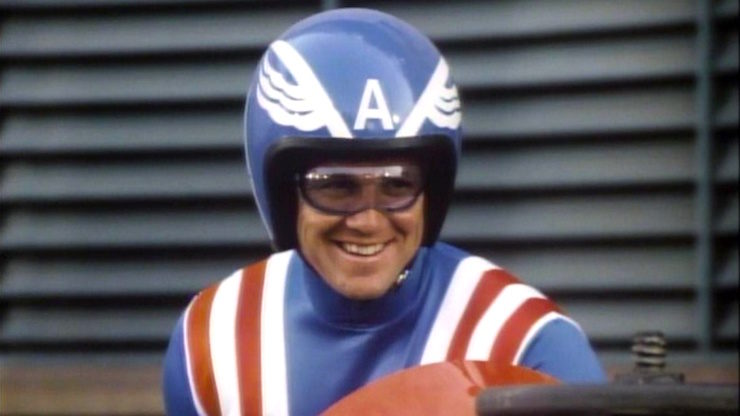Like the two movies we covered last week, Captain America and Captain America: Death Too Soon were TV movies intended as pilots for a new series. Hoping for the success of Wonder Woman, The Incredible Hulk, and Spider-Man, these two movies starring college football player turned actor Reb Brown as the star-spangled hero did not go to series, though unlike Dr. Strange and the first attempt at Wonder Woman (which we’ll get to next week), Cap at least got a second movie out of it—and it had Christopher Lee as the bad guy!
This is probably for the best, considering that the first thing they did was take the hero of World War II and remove him completely from that war, though that’s only the start of the problems with these two movies…
“Jam Captain America down their throats!”

Captain America
Written by Don Ingalls and Chester Krumholz
Directed by Rod Holcomb
Produced by Allan Balter
Original release date: January 19, 1979
Ex-Marine and former Motorcross star Steve Rogers is driving his van (with a motorcycle on the back) down the west coast to a surfing spot owned by a friend who is collecting his mail for him. His plan, now that he’s no longer serving, is to just drive around for a while.
His mail includes the third telegram from Simon Mills he’s received and a note from his old friend Jeff Haden. He calls the latter, but Haden can’t talk about what’s wrong over the phone. Rogers agrees to meet him that night, and meantime he’ll head to Thousand Oaks to find out what this Mills fella wants.
Rogers is being followed by a suspicious-looking man in a green sedan, who has set up a fake construction site in order to detour Rogers to the mountain road, which has been drenched in oil. Rogers’s van spins out and goes over a cliff. He survives, though his shirt is very artfully torn and both van and motorcycle are trashed.
In the next scene, Rogers is meeting with Mills, wearing a new shirt. No explanation of how he got out of the cliff, or why the bad guys who set him up didn’t finish the job, or where he got the new shirt. Mills used to be Rogers’s father’s assistant, and he’s continuing the old man’s work, which Rogers himself is unfamiliar with.
Turns out that Rogers’s father developed a formula called FLAG—full latent ability gain—that is a super-steroid derived from the doctor’s own adrenal gland. FLAG can allow a person to use one hundred percent of his or her capacity, instead of the one third we usually use.
The problem is that FLAG only works for two weeks, and then the subject dies. The only person on whom it worked was Rogers’s father, who apparently fought crime secretly, and reported directly to the president. Mills and the new scientist in charge of FLAG, Dr. Wendy Day, ask him if they can perform some tests on him, since he’s a blood relative of the original donor, and the only person on whom it’s worked permanently. But Rogers has served his country in the Marine Corps, and now he just wants to relax, see America, and figure out who he is.

He then visits Haden’s house, only to find his home office trashed, and the man himself delirious and injured. Haden dies in Rogers’s arms.
Lou Brackett arrives at the Andreas Oil Company. His people were behind Rogers’s road accident, and also the attack on Haden. Apparently, the intent was to kill Rogers and to retrieve film from Haden, but the film’s not there, and Brackett’s thug killed Haden by mistake. He also saw Rogers visit the house. Angrily, Brackett orders his two main thugs, Harley and Rudy, to find Rogers and see what Haden might have said to him before he died.
Brackett needs the film so a scientist in his employ, Lester Wiant, can complete a neutron bomb. Without Haden’s film, he can’t finish his work.
To Rogers’s surprise, Mills shows up at the crime scene, along with the FBI. It turns out that Haden worked for Mills also. Rogers answers several questions, and also gets to break the bad news to Haden’s daughter, Tina.
Mills finally reveals that what Haden was working on was a neutron bomb. Mills is concerned that Haden was giving away secrets of the bomb, but Rogers refuses to believe that.
Harley calls Haden’s house to talk to Rogers, and says that he knows who was responsible for killing Haden and to meet him at a gas station off I-5. Rudy and Harley question him about where the film is, at which point Rogers realizes that they’re the bad guys. He hops on his motorcycle and drives off, Rudy and Harley giving chase in their car. In order to avoid hitting another car, Rogers goes over a cliff, his motorcycle exploding.
He’s taken to a hospital and operated on, with Mills observing. He’s dying, and so Mills has Day bring the FLAG serum, which Mills himself injects into Rogers. He flatlines, and then not only revives on his own, but grabs Mills’s arm in a death grip. His EEG is off the charts, but a sample of his blood reveals that the formula has taken.
As Rogers recovers, he tells Mills about the oil slick, which he thought was an accident, but now he thinks it was an attack. He also refuses to go along with any testing of what FLAG has done. He just wants to live a normal life, and he didn’t ask to be injected with a super-steroid. He’s grateful that his life was saved, but that’s as far as he’s willing to go.
Then Harley shows up and points a gun at him, kidnapping him to a meat packing plant. Harley wants to know where the film is; Haden took the pictures for his boss, then he “got cute,” and then he died. Rogers has no idea where the film is, and after being punched in the gut once, he breaks the ropes holding him and throws Harley and the two thugs around like rag dolls. After hoisting them up onto hooks, he calls the FBI.
Mills finds Rogers sketching on the beach. Rogers is worried about what these powers mean—he is worried that he might hurt someone or break something he shouldn’t. Mills reveals that Rogers’s father was nicknamed “Captain America” by some of the bad guys he stopped. It was meant mockingly, but he took it to heart.
Mills also offers him a job fighting injustice with his new powers, working for Mills and the president. Rogers says he’ll think about it, and also gives Mills a sketch of himself in a star-spangled costume.
Rogers then spends time with Day, who Mills sent to recruit him. However, she’s not sure she wants him to join up, considering he’s already been run off the road, blown up, and kidnapped. Maybe he should get the message? They also smooch because it’s 1979 and she’s the female lead, and she’s supposed to smooch the hero. Sigh.
Mills arrives and reports that they can’t find anyone suspicious in Haden’s background. He worked with an industrialist named Brackett on some endowments for the university, but Brackett is clean. (Ha ha ha.)
Among Haden’s last words to Rogers were his wife’s name. Said wife died in a plane crash that was ruled an accident, but Rogers isn’t sure now, given that, of all things, that’s what Haden chose for his final words. Rogers suggests that Day have lunch with Tina, see if she remembers anything. Meanwhile, Mills takes Rogers to a government weapons test center, where he’s had Rogers’s van repaired and tricked out, and also given him a fancy-shmancy red-white-and-blue motorcycle and a flag-themed shield.
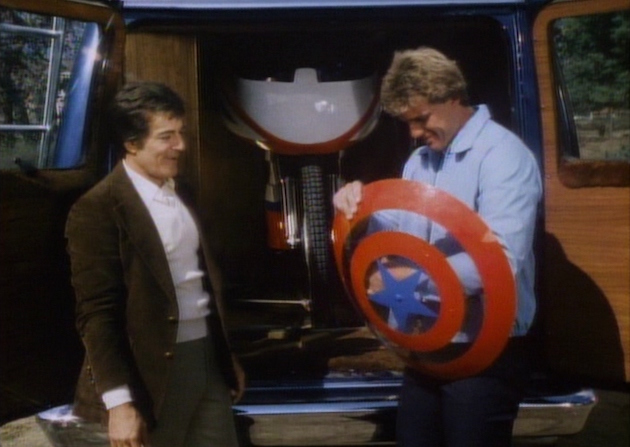
Rogers takes the bike out for a (very long) spin—the bike has jets and rockets, as well as a silent mode. Then a chopper shows up that somehow managed to get onto this classified government weapons testing base and its occupants start shooting at Rogers.
Mills grabs the MPs to go after the chopper, meanwhile Rogers jumps off his bike and onto the chopper, tossing the sniper into a lake and ordering the pilot to land. Mills is happy as a schoolboy at Rogers’s abilities—inexplicably unconcerned about the chopper that just got onto a military base and shot at his prize specimen.
Brackett decides to work on Tina, hoping she might know where the film is. Posing as a concerned friend, and telling her the film will exonerate her father of being accused of spying, Brackett asks if she might have some idea. They figure it out from an old game they used to play, and Brackett finds the film in Haden’s fishing rod.
Day arrives for her lunch date with Tina, and Brackett then kidnaps both of them at gunpoint. Brackett calls Mills and tells him to keep his nose, as well as those of the FBI and Rogers, out of this. Rogers, however, now has super-hearing and he can hear the background of Mills’s phone call, which is enough to indicate that Brackett is the bad guy.
Rogers wants to go in alone, as a big force will likely result in Tina and Day’s deaths. Mills agrees, and also gives him a disguise based on his sketch so that he can be Captain America instead of Steve Rogers, which will protect him from further attacks on his person. Besides, he needs to wear something protective while riding the bike anyhow. As justifications for a secret costumed identity go, I’ve heard worse…
Rogers drives to Andreas, parks the van, and then changes clothes and heads in on the motorcycle, putting it in silent mode. He goes as far as he can on wheels, then continues on foot, doing his best to avoid the guards, including using the same oil-slick trick they used on his van earlier. Karma’s a bitch.
Wiant arrives and sees what’s happening. He tries to run away, but Cap catches him and forces him to Brackett’s office, and after removing his files on Haden, frees Tina and Day. Wiant reveals that Brackett plans to detonate the neutron bomb at noon, and that they already pulled out, but Wiant won’t say where or why.
Since Wiant said, “pull out,” the bomb is probably on a truck, which means they’ll be within five hundred miles of L.A. Mills has the computer print out viable targets, and they settle on a depository filled with gold bullion as the likely target. Mills and Rogers take a chopper to try to find an Andreas truck on the road near the depository. After they find it, they land in a nearby clearing, and Cap goes out on his bike to go after the truck.
Cap climbs onto the truck, ditching the bike (it’s okay, Mills sends people to pick it up), and then he bends the exhaust pipe so it blows into the truck via the air vent. Brackett starts to choke and eventually falls unconscious. Rudy has the truck pulled over to find out what’s going on. Cap knocks Rudy and the other thug out. He secures the bomb, but then he discovers that Brackett is wearing a dead-man’s switch and he’s—somehow—dying from inhaling truck exhaust. Sure.
Mills lands the chopper and brings a first-aid kit to save Brackett so they don’t all go boom.
Then it turns out that Tina’s mother is alive—Brackett’s been holding her prisoner all this time after faking the plane crash in order to blackmail Haden into betraying the government. Tina is reunited with her mother, Rogers has agreed to remain as Captain America, and all’s right with the world.
“You didn’t expect to fool an old jungle fighter with a boomerang trick like that.”

Captain America II: Death Too Soon
Written by Wilton Schiller & Patricia Payne
Directed by Ivan Nagy
Produced by Allan Balter
Original release date: November 23, 1979
The second movie opens by reusing footage of Rogers driving his van down the Pacific Coast Highway from the first movie, then we cut to the beach, where Rogers is doing sketches for people. His latest client is an older woman named Mrs. Shaw, who tells him about how the local old folks are getting mugged when they cash their pension checks.
Sure enough, she gets jumped when she cashes her check—but Captain America is on the case! He gets Mrs. Shaw’s purse back, knocks one mugger out with his shield, and chases the other down on the beach (despite his being in a dune buggy and Cap chasing him on foot (I have no idea why he left his jet-powered motorcycle behind (maybe he thought it would be more intimidating to chase him on foot?))).
A microbiologist who works for Mills missed a senate hearing—testimony he had offered voluntarily. Professor Ian Ilson is very private, and often doesn’t check in for days at a time, but when Mills goes to his lab, he finds it trashed, Ilson himself missing. He tried to write something before he was taken: “MIGU.”
Mills calls in Rogers and Day and reveals that “MIGU” refers to Miguel, a revolutionary who is responsible for numerous kidnappings of diplomats and also several bombings. We then meet Miguel, who is posing as the warden of the Waterford Federal Penitentiary. He has Ilson working on a project related to his research on aging, and he’s horribly behind Miguel’s production schedule.
Ilson’s research involved an illegal drug; Mills was able to get special permission to import it, but anyone else who wants it would have to smuggle it. The drug only comes from Ecuador, and a ship that has a history of smuggling just came in last night from Ecuador. Cap investigates, plowing through some crates with his bike for no compellingly good reason, and then assaults several dockworkers. These guys have done nothing wrong—Cap’s the one who trespassed (he drove through a chainlink fence and everything), and these guys just defended an attack.
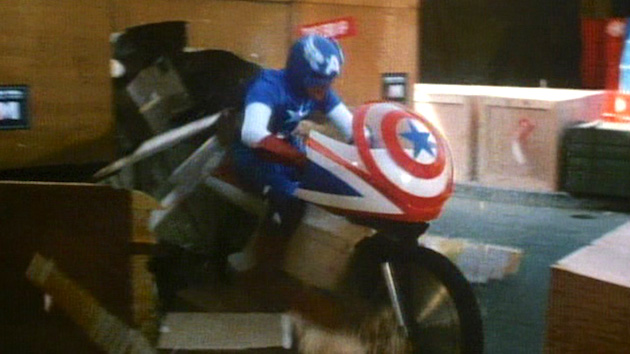
He finds the drugs in one of the crates labelled “machine parts” and liberates a sample, then seals the crate back up so he can track it. Day confirms that it’s the same drug Ilson used. Cap follows the crate—which is separated from the others and put into a van, which then transfers the cargo to a jeep. By the time Rogers catches up to the van in the small town of Belleville, it’s abandoned and empty. He was too far behind the van to catch the transfer. So he sets up his canvas and sketches near where the van was abandoned to see who comes for it. The van’s drivers see Rogers and check him out. They threaten him to get him to leave, though he only goes as far as the local vet (whom the thugs told him was on vacation). Said vet doesn’t seem to know what he’s doing, and the people visiting him are suspicious, particularly Helen, a mother visiting with her son Pete (though neither has an animal, nor does anyone else going in to see this alleged vet).
Rogers rents a room at a local boarding house, then starts asking around about a place to get away from it all. Everyone he meets in town is either threatening him or angry or scared.
Four guys show up with baseball bats and make it clear he isn’t welcome. Rogers capitulates and asks only to be able to gather his things. Once they’re away from the center of town, Rogers fights back, during which his shirt is tastefully ripped. (At one point, one of the thugs calls him “Rogers,” even though he hasn’t told anyone his last name.) Helen sees the fight and offers him a ride back to her place to take care of his injuries. In return, Rogers helps Pete with his chores. Pete reveals that his mother used to be happy when she competed as a show-rider, but she hasn’t done it since her husband, Pete’s father, died.
Pete finds an old sheep that Pete insists is his pet lamb, Whitey, who ran away. But this sheep is too old to be Whitey, even though he has the same scar that Whitey had. Pete is distraught.
One of Helen’s ranch hands is working for Miguel and passes on that Rogers saw the old sheep. Miguel orders his people to not allow Rogers to leave town. So the local sheriff arrests him for assault and battery (actually a legit charge, kind of). However, Rogers bends the bars and escapes the jail. Cap then rides through town, and everyone assumes that Cap broke Rogers out of jail. (It never occurs to anyone that Rogers is Cap, of course.)
The bad guys chase Cap down, trapping him on a dam, but Cap uses the bike’s rockets to jump over the bad guys—and then go over the edge, seemingly to his doom.
Miguel sent a lion cub to the White House, claiming to have given it a formula that would age it rapidly. Sure enough, it becomes a full-grown lion in less than a day. Miguel has threatened to use this formula on a city. However, the United States does not negotiate with terrorists, and even though Mills and Day have proven that Miguel isn’t bluffing, Bliss, the White House staffer who brought them the cub to test, makes it clear that they will not give in.
Unfortunately, Miguel has bugged Mills’s lab—probably via the lion—and hears this, so he drops Ilson’s gas on Portland, Oregon. He also leaves a sample of the antidote in Bliss’s hotel room, but Mills and Day can’t replicate the antidote.
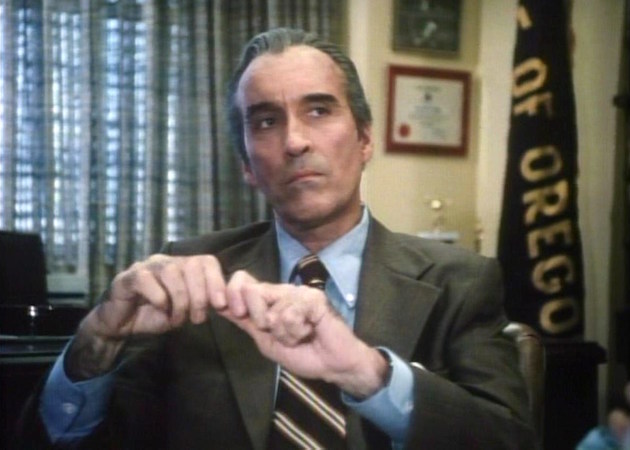
Day flies to Portland with the antidote to test it on a victim there. And then en route, she gives herself the formula so she can test the antidote.
Rogers goes to Helen and finds out the truth: Portland wasn’t the beginning, Belleville was. They sprayed the town with the aging formula and have been giving them small doses of the antidote to keep them from aging, and threatening to withdraw the antidote if they don’t keep silent.
Day tests the antidote on one of two twins, and it works. So they know for sure that it’s a legit cure, they just need more of it.
The fake vet gives the antidote shots to Belleville, and he always goes out of town for a few hours the day before the shots are to be given. Rogers has Pete go into the vet’s car on a pretense and check out his odometer. When the vet returns from his trip, Rogers checks the odometer again, and now they have a radius for where he could have gone. He also checks the tires for residue. With Helen’s help, they deduce that Waterford is where the vet probably went. Rogers manages to sneak past the checkpoints out of Belleville and heads to Waterford to talk to the new warden. Cap is able to get in through the gate as it’s closing (yay for jet-powered bikes!). Miguel has his lieutenant give the formula to some dogs and then sics them on Cap to cover his escape. However, Cap is able to hold them off and then frees Ilson. Unfortunately, Miguel has escaped with all of the antidote. Cap avoids the guards (aided at one point by throwing a bag of flour against a wall to create a smokescreen) and escapes on his bike—which, apparently, can now also double as a hang-glider. Sure.
As Cap glides his way out of Waterford, he tracks down Miguel’s car and gives chase on the road, dropping the hang-glider. Cap chases him to a dead end and so Miguel continues on foot, since apparently his car is incapable of making a U-turn. Cap chases him into the woods. Miguel tries to shoot him, and then throws the formula at Cap, but he tosses his shield to break it, and the formula instead splashes right into Miguel’s face. He ages far more rapidly than anyone else who took the formula does, and dies of old age in mid-grapple.
Cap brings the antidote to Mills, and he and Rogers take a helicopter to spray the antidote on Portland and cure the populace (though they’ve all aged about ten months).
Belleville is now freed from Miguel’s influence. Rogers sketches Helen riding her horse and also gives Pete a puppy.
“Minor flesh wound in the service of your country”
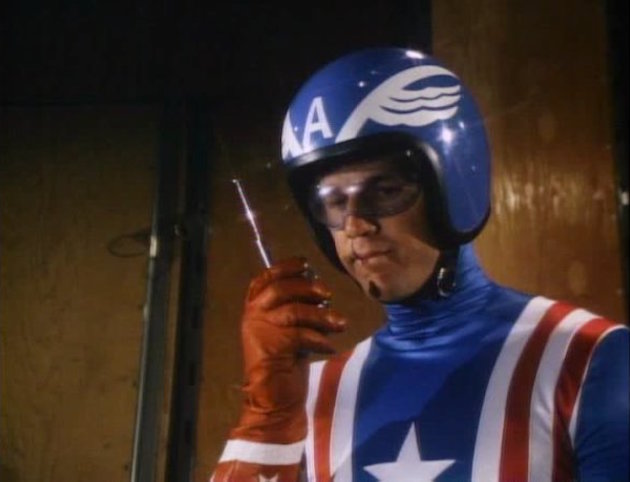
It’s amusing to watch these movies and see the various side characters, particularly after doing Star Trek rewatches on this site for six years. Several of the secondary characters have a history in Trek, including the late great Joseph Ruskin and Lance LeGault in the first one and Stanley Kamel and William Lucking in the second. Plus, of course, you’ve past and future genre greats Christopher Lee and Connie Sellecca in the second one.
As for the movies themselves, they share far more DNA with various action-adventure shows of the era (both before and after they aired) than they do any comic book version of Cap. The hero who goes off and saves the world while working for a fictional agency that is either part of the government or at least vaguely sanctioned by it, with a couple of people (usually one man and one woman, but not always) as his support structure. It’s the same formula as Wonder Woman, The Six-Million Dollar Man, The Bionic Woman, Knight Rider, Airwolf, MacGyver, and others.
Which makes these decent action-adventure shows, I guess, but never at any point does this feel like Captain America. More than any other hero, Cap has always been tied to a particular time and place: World War II. A skinny, sickly kid from the lower east side of New York (NOT BROOKLYN!!!!!) who volunteers for an experiment to improve his physique so he can fight Nazis. Tellingly, every other adaptation of Cap into live action will have this (not just the recent Chris Evans films, which felt the need to move him to Brooklyn for no compellingly good reason, but also the 1990 film with Matt Salinger, all of which we’ll tackle in due course).
Without it, there’s nothing here that has Cap’s essence. Hell, they don’t even really play up the patriot angle very much. I mean, yeah, he’s an ex-Marine (though he mentions attending West Point, which is an Army school, but we’ll let that go), and he works for the government, and he helps the little people, but that could be any hero. The fact that he starts out as a fit, muscular Marine doesn’t do anything to make him more heroic—the FLAG formula pretty much just turns him into a variation on Steve Austin (they even use similar sound effects to The Six-Million Dollar Man when he uses his powers). And he doesn’t exactly jump at being a hero, having to be practically put into a headlock to be talked into it by Mills and Day.
Also Reb Brown looks completely ridiculous in the outfit.
Brown at least does the best he can with the material, and he certainly has the earnestness down. I loved watching him take down the muggers who were stealing old folks’ pension checks. Sadly, his supporting cast isn’t all that and a bag of chips. Len Birman is mostly sleazy and creepy as Mills, neither Heather Menzies nor Sellecca do anything to make Day convincing as a scientist, and neither Steve Forrest nor Lee do much to impress as the bad guys. (Lee in particular makes an unusually minimal effort, counting on his voice to do his acting for him. Mind you, when you’ve got that voice, it can cover a multitude of sins, but still, it feels far too often like Lee is phoning it in.)
The writing on Death Too Soon is at least clever, with Rogers using his brains as much or more than he uses his brawn, whether it’s figuring out where the vet went based on his odometer and tire residue or throwing flour against the wall as a smokescreen or using his super-duper hearing to track Miguel’s movements through the forest.
But ultimately, these are only Captain America movies insofar as the outfit is similar to that of the comics and the guy’s name is Steve Rogers. The whole backstory with his never-named father as a superhero in the past is actually more interesting than anything either movie comes up with plotwise, and I find it hilarious that the one aspect of the comic book character they latched onto is the fact that Rogers is an artist. (In the comics they even had him drawing Marvel’s Captain America comic for a while, an amusingly meta subplot.)
Next week, we’ll look at another TV movie that strips its hero’s World War II roots away, as well as a spinoff of Christopher Reeve’s films, as we switch over to DC’s first attempts at Wonder Woman and Supergirl.
Keith R.A. DeCandido is still recovering from Dragon Con 2017. Read his entire con report on his blog, and pick up his latest book, Orphan Black: Classified Clone Report, available in bookstores or from all the usual online dealers.










